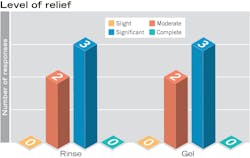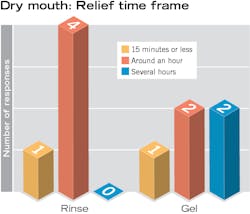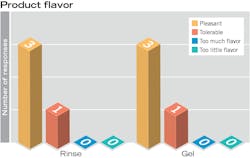Evaluating a new dry mouth product system: Valuable insider experiences
Trying to figure out what works
For a moment I’d like you to think about how hard it is to talk if your mouth is dry. What about trying to eat a meal or swallow a bite when there is not enough moisture to make the food go down your throat, or dreading eating a sandwich because half of the meal stays stuck to your teeth and gums? Do you know what it is like to wake up every few hours because your mouth is so dry you can’t sleep?
On a personal and professional level, dry mouth issues are now more important than ever. I’ve spent a significant amount of time over the last two decades learning about dry mouth and trying to figure out ways to help not only myself but patients, family members, and friends. Years ago, I learned there was no one perfect dry mouth product. The relative success of any product or protocol is very personal.
Meet the testers
Fifteen years ago, I started asking a very special group of people to test products. I knew my personal response to a product was simply not enough. I wanted to understand other people’s perspectives about ease of use, efficacy, flavors, and textures. Did a product really work for them and was it formulated in a safe pH range? My testers have literally tested dozens of products through the years. They say what they feel and let me know their unvarnished thoughts. Their comments and observations reflect their actual experiences. This group has taught me so much. When I was asked to write an article about a new dry mouth product platform, it was critical to get their input. Before we get into the product evaluation, let me introduce these special people to you.
Molly reports having severe dry mouth for at least 15 years, takes several medications that contribute to a dry mouth, and uses a CPAP nightly due to severe obstructive sleep apnea. She has an underlying breathing disorder that is allergy-based and is worse during cold weather. She follows a stringent exercise routine for pain management, so her hydration needs are significant, and she sips water and coffee throughout the day. She lives in a heavily populated mid-Atlantic urban area that is plagued with traffic-based air quality issues.
Lisa started having dry mouth issues about 30 years ago. Her issues got progressively worse during the first 20 years but have leveled off now. She lives in an urban southern California community that has a relatively dry, warm climate, and frequent air quality challenges. She has almost no salivary gland function but classifies her condition as mild to moderate.
Elise has had moderate to severe medication-based dry mouth issues for around 12 years. Her situation was much worse when she lived in Wisconsin where the climate is very dry in the winter. Climate is not an issue now that she lives in a semirural humid area of Florida, but exercise makes her dry mouth worse.
JoAnn is a dental hygienist who has lived with severe dry mouth for more than 25 years. She lives in a small city where the humidity is low to very low. She has multiple autoimmune disorders, and salivary gland dysfunction, and uses a BiPAP machine at night.
Anne is a professional speaker and spends time in low humidity environments: hotel rooms, airplanes, and desert climates. Pollen, dust, mold, mildew, and poor air quality trigger nasal congestion and she takes antihistamine medication periodically to manage seasonal and environmental allergies. She lives in a large urban area that has a mild climate and high humidity levels year-round, and uses a CPAP nightly to control mild sleep apnea.
The GUM Hydral Dry Mouth Relief System
In February 2020, Sunstar launched the GUM Hydral dry mouth product line at the Chicago Midwinter meeting. The GUM Hydral rinse, spray, and gel products contain ingredients focused on moisturizing the mouth tissues and providing lubrication. A combination of hyaluronic acid, betaine, taurine, and polyvinylpyrrolidone (PVP) create products that are highly viscous, work as amazing lubricators, help maintain proper hydration, support electrolyte balance, soothe soft tissue irritation, and create a protective film over the oral mucosa. These are big wins for those with dry mouth issues. GUM Hydral products are specifically formulated for those with sensitive mucosa and do not contain cariogenic sweeteners, sodium lauryl sulfate, alcohol, or strong flavorings. The products are safe for those sensitive to milk or eggs. Finally, the pH for these products is within a safe range, which is particularly critical for those with dry mouth. The rinse tests at pH 7 and the gel at pH 6.5. Sunstar confirmed that the pH range for the rinse is 6–7, and the gel range is 6–6.8.
Personal daily challenges
Everyone living with dry mouth has a unique story to tell. Panel members evaluated two GUM Hydral products: the rinse and the gel. Like any of our patients, the responses are based on personal experiences. After a week or so of testing, the panelists shared their thoughts in a short survey that contained comments describing their personal situations along with their experiences with the new products.
- I won’t eat anything that is very dry without water within reach. I still avoid French fries due to the dryness.
- Yes, I always need to drink while I eat.
Does dry mouth affect your speech?
- It makes it harder to sing in the choir.
- Sometimes it affects my speech, especially during speaking engagements.
Does it impact how foods taste?
- I lost my sense of taste years ago.
- Some days even favorite foods taste like nothing or have an off flavor. It’s pretty annoying.
Does dry mouth affect how you sleep?
- Definitely. Without a dry mouth product, I wake up two or three times a night from the discomfort.
- Only when my allergies are bothering me.
An oral moisturizer is a must at night. It is impossible to fall back asleep when my mouth is dry.
All five reported symptomatic relief and overall improvement in mouth comfort, but the responses varied when it came to length of time, level of relief, and taste perception (figures 1–3).
The test panelists provided additional valuable information. One tester commented that the texture of the rinse is perfect. “The viscosity is just right,” but she found the gel is less persistent than the rinse. Another had an opposite reaction. “The gel seemed to last longer since it felt like it coated my mouth. I don’t recall using anything like it before.” One panelist lost her sense of taste years ago. “I can’t taste so I don’t know how much flavor there was, but it wasn’t unpleasant.”
Final thoughts
Time is a huge issue for many clinicians. Our list of tasks for every appointment seems to grow longer every year and our patients are getting more and more complex. For the sake of survival, it is really tempting to focus on finishing an appointment on time. But is this truly comprehensive care? And are we providing patients with all of the options that can provide relief from common conditions such as dry mouth? From a patient-centered perspective, it makes sense to encourage patients to try new products and then really listen to their experiences. And if your practice truly wants to shine, why not conduct a taste test at the end of a dental hygiene appointment? Both you and your patients may just find the new perfect product!
What do I know about my testers? They are not looking for miracles; they just want products that make their lives better. They want products that help them sleep, eat, talk, and enjoy life. This is not a product pitch; this is asking dental professionals to consider any and all options that will help those with dry mouth find a way to make their mouths feel more normal.
ANNE NUGENT GUIGNON, MPH, RDH, CSP, a visionary thinker, has received numerous accolades over four decades for mentoring, research, and guiding her profession. As an international speaker and prolific author, Anne focuses is on the oral microbiome, erosion, hypersensitivity, salivary dysfunction, ergonomics, and employee law issues. She may be contacted at [email protected].










